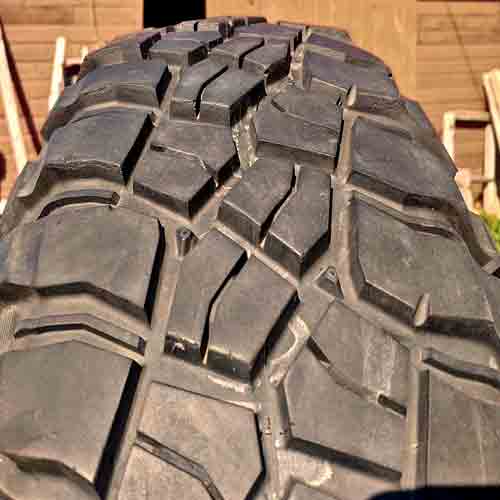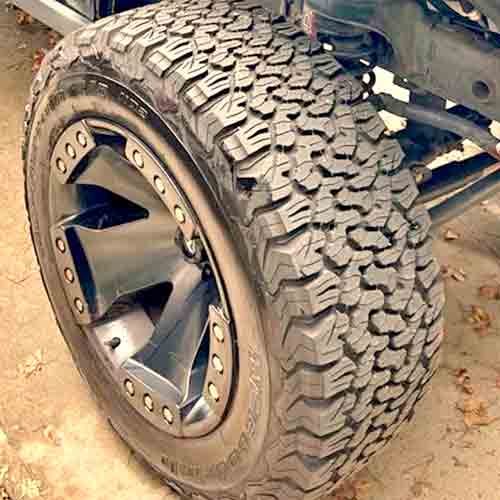The BF Goodrich KO2 is an all-terrain tire, while the BF Goodrich KM3 comes in the mud terrain category. Both tires are pretty great off-road, and provide very robust construction. Let’s check them out in detail.
Table of Contents
Available Sizes
Starting with BF Goodrich KM3, the tire has following sizes specs.
- 14 to 22 inches rims (56 total sizes).
- Speed rating: Q only.
- Load rating: C to F.
- Weight range: 37 to 83 lbs.
- Tread depth: 18/32″ on all sizes.
Review this tire here: https://tiredriver.com/bf-goodrich-km3-mt-review/
While the BFG KO2 provides you with following.
- 15 to 22 inches rims (92 total sizes).
- Speed Ratings: R, S, and Q
- Load ratings range: C to E
- Weight range: 35 lbs to 67 lbs
- Tread Depth: 15/32″ on all sizes (except for 4)
- Winter ratings: M+S & 3PMSF
- 50k miles warranty
Review this tire here: https://tiredriver.com/bf-goodrich-ko2-review/.
A Side Note: I worked with these guys to make the following video:
Design Comparison
Starting with the design of the mud terrain variant…

The BF Goodrich KM3 comes with a design that is anchored by two very prominent blocks at the center.
If you look at them closely, you’d note that these lugs are arranged laterally, with respect to shoulders.
They have huge gaps in between, where triangular stone ejectors are seen, and each of the lugs have thick slits in them.
There’s nothing more going on here.
The shoulder blocks are also very minimalist in design, devoid of additional tread features, though they still carry small notches on their sides, and have staggered outer margins.
Moreover, these lugs join together on sidewalls and make thick sidewall lugs, interspersed with deep biters.
On the contrary, the BF Goodrich KO2 presents a different style, having less aggressive overall character.

This tire’s design begins with relatively smaller, worm-shaped blocks at the center.
These blocks are furnished with full-depth notches and sipes, which flex open as the lugs respond to the terrain.
Note the sipes here are not as thick as the KM3, and they are more in number.
This design choice not only offers impressive off-road performance, but also maintain a solid wet road traction.
Though the shoulders on the tire still hold more aggressiveness.
The angular cuts on these lugs enhance biting abilities, while the staggered edges provide efficient soft terrain evacuation.
Moreover, the tire although doesn’t offer as aggressive of the overall sidewalls, as the KM3, they are still pretty great, (as seen with lowered air pressure flexing).
Dry Traction
As you may be aware, mud tires aren’t typically praised for their exceptional performance on roads or asphalt, and the BF Goodrich KM3 is no exception to this rule.
Due to wider tread voids, the tire presents a somewhat limited area for surface contact, leading to a more compromise, in terms of grip.
Though its best to note that, there are two types of grip, and the KM3 still does a good enough job when it comes to directional grip, as seen with braking distance tests.
But still its handling really needs help, and it makes sense. Its shoulder lugs are notably voided, and when paired with the softer tread compound and extensive tread depth, this leads to increased over and under-steering on corners. And that leads to larger handling (lap) times on average (on tests).
In contrast, the BF Goodrich KO2 boasts a more tightly spaced rib placement, facilitating better interaction with the road surface. I mean its shoulders are also very wild, but they still interact a little better with the road, where the tire’s smaller (average) weight also does not produce as much inertia.
Wet Performance
In terms of wet traction, the BF Goodrich KO2 significantly outperforms the KM3, where siping and tread composition are the most crucial components to consider.
The KO2 basically comes with interlocking full-depth sipes on all of its lugs, and these pick up water particles more efficiently in comparison.
Moreover, the tire’s worm like design is also very effect at offering decent hydroplaning resistance.
Conversely, while the KM3 also offers hydroplaning resistance, its smoother design and lack of full-depth siping don’t evacuate water as efficiently.
So you can say, it does a good job at escaping water through grooves, but left over water coming right below the lugs has nowhere to go, as those blocks are missing with efficient siping, a story of almost all mud terrain tires.
Fuel Economy and Tread Life
Both performance factors relate to the tire’s rolling resistance, which is affected by weight and tread composition (of the tire).
That’s why it makes sense why the BF Goodrich KM3 with its thicker internal plies and outer rubber, exerts greater pressure on the road, creating more significant rolling resistance, affecting fuel economy negatively, and generating heat, which reduces tread life.
The BF Goodrich KO2, on the other side, even though has 3 ply sidewalls, still weighs a lot less in comparison, so it gets to come out with a superior fuel economy.
And yes this also helps the tire to have a better overall tread life too, so it makes sense why it comes with 50k miles warranty, whereas you don’t get any with the mud terrain variant.
Noise Production
Tire noise primarily stems from airflow striking the tread walls. This is because the air particles enter (mainly through tread edges and shoulders), and produce noise waves upon impacting with the tread walls.
Also the noise also sometimes echo off the walls, adding to the overall process.
Now, the BF Goodrich KM3, with its aggressive structure allow more air to come in, where it’s softer tread compound also isn’t so great at dampening the echoing as well.
Whereas on KO2, you get a more compact structure, and a superior pitch sequencing technology, so noise is dampened down to a greater degree.
(This technology involves varying the lugs’ geometry, which creates different tones that ultimately cancel each other out).
Winter Performance
Winter traction is also an area, where the all-terrain variant is taking the lead.
The KO2 with its Three-Peak Mountain Snowflake (3PMSF) rating, unsurprisingly provides superior acceleration on hard-packed snow, where it features superior snow to snow contact.
It’s worm like structure of the lugs, simply provide a superior area where (trapped-in-them) snow particles could meet others on the ground, (which is significant because snow sticks better on snow).
Side Note: The 3PMSF rating indicates the tire’s enhanced snow traction capabilities – about 10% better than an average all-season tire, as per my communication with BF Goodrich. However, this doesn’t imply improved braking or handling in snow.
In contrast, the KM3 only holds an M+S rating, and is missing with 3 peak rating, making it poorly suited for icy and hard-packed snow conditions.
Nevertheless, it can handle deep, fluffy snow, thanks to its thick lugs that work to displace the snow, providing forward momentum.
Despite this, neither tire can match the traction provided by a dedicated winter tire.
Off-Road Performance
Given the variety of off-road terrains, it’s essential to evaluate these tires’ performance in diverse environments. Check below, where I discussed how each of them performed on various terrains.
Rocks
On rocky terrains, the BF Goodrich KM3 shines with its remarkable durability, thanks to its thicker three-ply sidewalls and Kevlar reinforcements.
Moreover, its larger tread depth, softer lugs, and broader groove notches provide excellent multi-directional grip too.
In contrast, the BF Goodrich KO2 being lighter, only offers the benefit of forward momentum, but lacks as much of the lateral traction in comparison (which a very important component, as it prevents over-turning of the vehicles).
Mud
Unsurprisingly, the BF Goodrich KM3 is superior in muddy conditions due to its excellent self-cleaning capabilities, with its larger shoulder tread voids and notches. And here, the BF Goodrich KO2’s lugs seem relatively insignificant.
In fact KO2’s worm like design is very bad when it comes to mud and even wet grass. Its interlocking lugs basically are not so great at letting go off the accumulated mud, even though it also features triangular ejectors like the Km3.
Sand
On sandy terrains, the BF Goodrich KO2 outperforms its counterpart, thanks to its more optimized sidewall lugs and newer generation rubber offering an excellent footprint, a critical factor for navigating in sand.
But still, despite being heavier, the KM3’s robust rim locks and thicker sidewall lugs allow it to achieve impressive sand traction when the tire pressure is reduced.
Conclusion
While many categorize the BF Goodrich KO2 as a pretty aggressive tire, it’s not specifically designed for all off road purpose, despite its commendable performance.
In contrast, the BF Goodrich KM3, an aggressively designed mud terrain tire, surpasses its counterpart in most off-road situations, especially on mud and rocks. However, both tires perform similarly on sand.
And on both dry and wet asphalts, we have KO2 taking the lead, offering a quieter ride, superior fuel economy, and longer tread life.
Though its wet traction still isn’t that great, I mean when you compare it with other all terrain tires out there. But yes, compared to KM3, its still better.